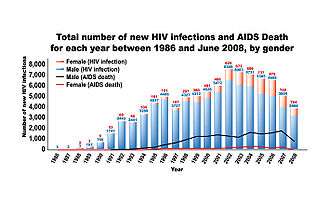HIV/AIDS in Malaysia
The first HIV case in Malaysia made it debut in 1986 and since has become one of the country's most serious health and development challenges.[1] As of end 2015, it is estimated that there were 93,000 people living with HIV in the nation.[2]
Malaysia is ranked fourth highest in adult prevalence of HIV/AIDS in Asia after Thailand, Papua New Guinea and Indonesia with a 0.45% prevalence rate.[3]
Prevalence


Malaysian HIV/AIDS cases have been reported since 1986 by the Ministry of Health. Since then, the national surveillance system had reported a cumulative of 105,189 HIV cases, 21,384 AIDS and 17,096 deaths related to HIV/AIDS giving total reported PLHIV of 88,093 cases or 96% of estimated PLHIV.[4]
Males still make up the majority of HIV cases (90%), but the number of women with positive status of HIV has been increasing. This is shown by the decreasing trend of male:female ratio of 10:1 in 2002 to 4:1 in 2013.[5] 34% of the cumulative HIV infection are among young adults; between the age of 13 and 29.
Between January to June 2014, 1,676 cases of HIV and 598 cases of AIDS with 402 deaths were recorded.[6] Out of this new infection, 79.7% are men.
Means of Transmission
In 2013, heterosexuals transmission recorded the highest (51%), followed by Injecting Drug User (22%) and Homo/Bisexual transmission (22%). According to the Ministry of Health, at present (2016), 70% of HIV transmission are transmitted through heterosexual relationships, mainly from female sex workers to male clients.[7]
Means of Transmission (2013)[5]
Incidence & Mortality Rate
| Disease | Incidence Rate | Mortality Rate |
|---|---|---|
| HIV | 11.42 | 0.58 |
| AIDS | 4.00 | 1.62 |
At-risk group
The HIV epidemic in Malaysia is concentrated in these key populations;[5]
- Sex workers
- Sex worker accounts for 0.6% of total reported cases thus far. However, the number of cases reported among sex workers are grossly under reported.[1] In 2014, Integrated Bio-Behavioral Surveillance (IBBS) in female sex workers shows an increase of sex workers living with HIV to 7.3% from 4.2% in 2012.[4]
- Transgender
- Injecting Drug Users
- Men who have sex with men (MSM)
- IBBS conducted in 2012 shows 7.1% of MSMs is living with HIV. In 2014, the figure has increased to 8.9%.[4]
Treatment
The first line of highly active antiretroviral therapy is provided for free in Malaysia by the Ministry of Health since 2006.[9] However, only 28% of HIV/AIDS patients seek consistent treatment as the awareness among patients to get treatment was still low because they were ashamed to seek treatment and did not know about the various types of treatment provided by the government to help them fight the disease.[10] The government hopes the figure will reach 90% in line with the National Strategic Plan Ending AIDS 2016-2030.[10]
Local Support
- Malaysian AIDS Council (MAC) is a Malaysian non-profit organisation with a mission to represent, mobilise and strengthen non-governmental organisations and communities who were working with HIV/AIDS issues.
- PT Foundation (formerly known as Pink Triangle) is a community-based organisation "providing HIV/AIDS education, prevention, care and support programs, sexuality awareness and empowerment programs for vulnerable communities in Malaysia". The communities include MSM (men who have sex with men), transgender, sex workers, drug users, and people living with HIV.
- Pertubuhan Wanita dan Kesihatan, Kuala Lumpur (WAKE)
- Kuala Lumpur AIDS Support Services Society (KLASS)
- APCASO - Asia Pacific Council of AIDS Service Organizations
- Tenaganita is a human rights organisation dedicated in assisting, building, advocating and protecting migrants, refugees, women and children from exploitation, abuse, discrimination, slavery and human trafficking.
References
- 1 2 3 "The Global AIDS Response Progress Report 2014" (PDF). UN Aids. Retrieved 12 November 2015.
- ↑ "People living with HIV/AIDS urged to go for screening". The Star (Malaysia). Retrieved 29 May 2016.
- ↑ "COUNTRY COMPARISON :: HIV/AIDS - ADULT PREVALENCE RATE". Central Intelligence Agency. Retrieved 9 July 2016.
- 1 2 3 4 5 6 "The Global AIDS Response Progress Report Malaysia 2015" (PDF). UN Aids. Retrieved 14 April 2015.
- 1 2 3 4 "Annual Report 2013" (PDF). Malaysia Aids Council, Malaysia Aids Foundation. Retrieved 29 September 2014.
- ↑ "HIV/AIDS claim 16,742 lives in Malaysia since 1986". Astro Awani. Retrieved 29 September 2014.
- ↑ "HIV mostly spread through heterosexual relations". The Star (Malaysia). Retrieved 14 July 2016.
- ↑ "Kadar Insiden & Kematian Akibat Penyakit Berjangkit". Ministry of Health. Retrieved 29 September 2014.
- ↑ "Guidelines for the Management of Adult HIV Infection with Antiretroviral Therapy" (PDF). Ministry of Health. Retrieved 15 April 2016.
- 1 2 "Only 28% of HIV/AIDS patients seek consistent treatment: Dr Hilmi". The Sun Daily. Retrieved 15 April 2016.
External links
- Malaysian AIDS Council
- Department of Public Ministry of Health Malaysia - Section of AIDS/ STD, Division of Disease Control

